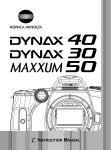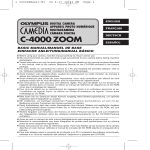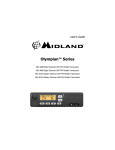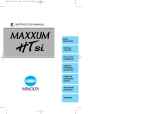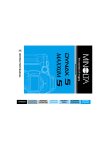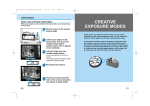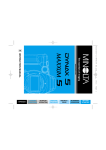Download Minolta Maxxum 70 QD 35mm SLR Camera
Transcript
INSTRUCTION MANUAL FOR PROPER AND SAFE USE Read and understand all warnings and cautions before using this product. WARNING Using batteries improperly can cause them to leak harmful solutions, overheat, or explode which may damage property or cause personal injury. Do not ignore the following warnings: • • • • • • • • • • 2 Only use the batteries specified in this instruction manual. Do not install the batteries with the polarity (+/–) reversed. Do not use batteries which show wear or damage. Do not expose batteries to fire, high temperatures, water, or moisture. Do not attempt to short or disassemble batteries. Do not store batteries near or in metallic products. Do not mix batteries of different types, brands, or ages. Do not use leaking batteries. If fluid from the batteries enters your eye, immediately rinse the eye with plenty of fresh water and contact a doctor. If fluid from the batteries makes contact with your skin or clothing, wash the area thoroughly with water. Tape over lithium battery contacts to avoid short-circuiting during disposal; always follow local regulations for battery disposal. Do not disassemble this product. Electric shock may cause injury if a high voltage circuit inside the product is touched. Take the product to a Konica Minolta service facility when repairs are required. FOR PROPER AND SAFE USE WARNING • Immediately remove the batteries and discontinue use if the camera is dropped or subjected to an impact in which the interior, especially the flash unit, is exposed. The flash has a high voltage circuit which may cause an electric shock resulting in injury. The continued use of a damaged product or part may cause injuries. • Keep batteries or small parts that could be swallowed away from infants. Contact a doctor immediately if an object is swallowed. • Store this product out of reach of children. Be careful when around children, not to harm them with the product or parts. • Do not fire the flash directly into the eyes. It may damage eyesight. • Do not fire the flash at vehicle operators. It may cause a distraction or temporary blindness which may lead to an accident. • Do not look at the sun or strong light sources directly through the viewfinder or lens. It may damage your eyesight or cause blindness. • Do not expose this product to liquids or operate this product with wet hands. If liquid enters the product, immediately remove the batteries and discontinue use. The continued use of a product exposed to liquids may cause damage or injury through fire or electric shock. • Do not use the product near inflammable gases or liquids such as gasoline, benzine, or paint thinner. Do not use inflammable products such as alcohol, benzine, or paint thinner to clean the product. The use of inflammable cleaners and solvents may cause an explosion or fire. • If the product emits a strange odor, heat, or smoke, discontinue use. Immediately remove the batteries taking care not to burn yourself. The continued use of a damaged product or part may cause injuries. • Take the product to a Konica Minolta service facility when repairs are required. 3 CAUTION • Do not point the product directly at the sun. If sunlight is focused on an inflammable surface, a fire may result. Replace the lens cap when the product is not in use. • Do not use or store the product in a hot or humid environment such as the glove compartment or trunk of a car. It may damage the product and batteries which may result in burns or injuries caused by heat, fire, explosion, or leaking battery fluid. • If batteries are leaking, discontinue use of the product. • Do not fire the flash while it is in contact with people or objects. The flash unit discharges a large amount of energy which may cause burns. • Do not apply pressure to the data panel. A damaged panel may cause injury, and the liquid from the panel may cause inflammation. If liquid from the panel makes contact with skin wash the area with fresh water. If liquid from the panel comes in contact with the eyes, immediately rinse the eyes with plenty of water and contact a doctor. Konica Minolta is a trademark of Konica Minolta Holdings, Inc. Dynax and Maxxum are trademarks of Konica Minolta Camera, Inc. 4 FOR PROPER AND SAFE USE TABLE OF CONTENTS Thank you for purchasing this camera. Please take time to read this manual so that you can enjoy all the features of your new camera. Names of parts ............................................................................................8 Data panel .....................................................................................10 Viewfinder ......................................................................................11 Getting started ..........................................................................................12 Attaching the strap ........................................................................12 Attaching a lens.............................................................................13 Removing a lens............................................................................13 Installing batteries..........................................................................14 Battery condition indicator .............................................................15 Loading film ...................................................................................16 Diopter adjustment ........................................................................17 Setting the date and time - Date model ........................................18 Changing batteries - Date model ..................................................19 Basic operation ..........................................................................................20 Turning on the camera ..................................................................20 Handling the camera .....................................................................20 Taking a picture .............................................................................21 Focus signals.................................................................................22 Special focusing situations ............................................................22 Focus lock .....................................................................................23 Flash modes ..................................................................................24 Flash signals..................................................................................25 Flash range....................................................................................25 Subject programs ..........................................................................26 Film rewind ....................................................................................28 Manual rewind ...............................................................................29 A short guide to photography .....................................................................30 What is a stop? What is an Ev? ....................................................31 Advanced operation ...................................................................................32 Mode dial .......................................................................................32 About full-auto program.................................................................33 Program - P ...................................................................................34 Aperture priority - A .......................................................................35 Shutter priority - S .........................................................................36 About shutter speeds ....................................................................37 What is an f-number? ....................................................................37 Manual exposure - M.....................................................................38 5 Metering in manual exposure ........................................................39 Bulb exposures..............................................................................40 Attaching the eyepiece cap ...........................................................41 Optional viewfinder accessories....................................................41 Exposure compensation ................................................................42 Depth of field preview....................................................................43 AE lock button ...............................................................................44 About slow sync. ...........................................................................45 AF button .......................................................................................46 Manual focus - MF.........................................................................48 Function dial ..................................................................................49 Audio signals .................................................................................49 Drive modes ..................................................................................50 Continuous-advance notes............................................................51 Self-timer notes .............................................................................51 Remote control notes ....................................................................52 Multiple exposures.........................................................................53 Exposure bracketing......................................................................54 AF modes ......................................................................................56 Manual ISO....................................................................................57 Metering modes.............................................................................58 Red-eye reduction .........................................................................59 Wireless/Remote flash...................................................................60 Wireless/Remote flash notes.........................................................62 Date imprinting - Date model ........................................................63 Custom functions...........................................................................64 Custom 1 - AF/shutter priority...........................................66 Custom 2 - Film rewind ....................................................66 Custom 3 - Film leader .....................................................66 Custom 4 - DX memory ....................................................67 Custom 5 - Shutter lock (film)...........................................67 Custom 6 - Focus-hold button ..........................................67 Custom 7 - Program shift .................................................68 Custom 8 - AF button .......................................................69 Custom 9 - AEL button .....................................................70 Custom 10 - AF illuminator ...............................................70 Custom 11 - Flash metering .............................................71 Custom 12 - Focus area illumination................................72 Custom 13 - Shutter lock (lens)........................................72 Custom 14 - Shutter lock (back).......................................72 Custom 15 - Date format (Date model) ............................73 Custom function reset ...................................................................73 6 TABLE OF CONTENTS Accessory notes .........................................................................................74 Lens notes .....................................................................................74 Accessory flash notes ...................................................................76 High Speed Sync. (HSS)...............................................................77 Wireless Controller IR-1N..............................................................77 Troubleshooting..........................................................................................78 Care and storage .......................................................................................80 Operating conditions......................................................................80 Storage ..........................................................................................80 Cleaning ........................................................................................81 Before important events ................................................................81 Questions and service...................................................................81 Technical specifications..............................................................................82 This device complies with Part 15 of the FCC Rules. Operation is subject to the following two conditions: (1) This device may not cause harmful interference, and (2) this device must accept any interference received, including interference that may cause undesired operation. Changes or modifications not approved by the party responsible for compliance could void the user's authority to operate the equipment. This equipment has been tested and found to comply with the limits for a Class B digital device, pursuant to Part 15 of the FCC Rules. These limits are designed to provide reasonable protection against harmful interference in a residential installation. This equipment generates, uses and can radiate radio frequency energy and, if not installed and used in accordance with the instructions, may cause harmful interference to radio communications. However, there is no guarantee that interference will not occur in a particular installation. If this equipment does cause harmful interference to radio or television reception, which can be determined by turning the equipment off and on, the user is encouraged to try to correct the interference by one or more of the following measures: • Reorient or relocate the receiving antenna. • Increase the separation between the equipment and the receiver. • Connect the equipment to an outlet on a circuit different from that to which the receiver is connected. • Consult the dealer or an experienced radio/TV technician for help. This Class B digital apparatus complies with Canadian ICES-003. This mark on your camera certifies that this camera meets the requirements of the EU (European Union) concerning interference causing equipment regulations. CE stands for Conformité Européenne (European Conformity). 7 NAMES OF PARTS *This camera is a sophisticated optical instrument. Care should be taken to keep these surfaces clean. Please read the care and storage instructions in the back of this manual (p. 80). Self-timer lamp / Remote-control receiver (p. 51, 52) Shutter-release button (p. 21) Control dial Flash* (p. 24) Function button Function dial (p. 49) Strap eyelet (p. 12) Flash-mode button (p. 24) Exposure-compensation button (p. 42) Lens release (p. 13) Lens mount Mirror* Lens contacts* Depth-of-field preview button (p. 43) The battery-chamber door (p. 14) and tripod socket are located on the bottom of the body. 8 NAMES OF PARTS Eyepiece cup Accessory shoe Mode dial / Main switch (p. 32, 20) Data panel Strap eyelet (p. 12) Manual-rewind button (p. 29) Back-cover release (p. 16) Viewfinder* Film window Focus-mode button (p. 48) AE lock button (p. 44) AF button (p. 46) Diopter-adjustment slider (p. 17) Slide the supplied eyepiece cup around the viewfinder frame. 9 DATA PANEL 1. Subject program indicators (p. 26) 2. Exposure-compensation indicator (p. 42) 3. Aperture display 4. Manual-focus indicator (p. 48) 5. Metering-mode indicator (p. 58) 6. Battery-condition indicator (p. 15) 7. Remote-control indicator (p. 50, 52) 8. Frame counter 9. Film-transport signals 10. Cartridge mark 11. Direct Manual Focus indicator (p. 56) 12. AF-mode indicators (p. 56) 13. Wireless / Remote flash indicator (p. 60) 14. Red-eye reduction indicator (p. 59) 15. Flash-mode indicators (p. 24) 16. High-speed sync. indicator (p. 77) 17. Self-timer indicator (p. 51) 18. Date-imprinting indicator (p. 63) (Date model) 19. Single-frame / Continuous advance indicator (p. 50) 20. Shutter-speed display 21. Multiple-exposure indicator (p. 53) 22. Exposure-bracketing indicator (p. 54) 10 NAMES OF PARTS VIEWFINDER Wide focus frame Spot metering area (p. 58) Spot focus area (p. 46) Local focus areas (p. 46) 1. Flash indicator (p. 25) 2. High-speed sync. indicator (p. 77) 3. Wireless / Remote flash indicator (p. 60) 4. Manual focus indicator (p. 48) 5. AE lock indicator (p. 44) 6. Focus signal (p. 22) 7. Shutter-speed display 8. Exposure-compensation indicator (p. 42) 9. Aperture display 10. Metering-mode indicator (p. 58) 11. Ev scale (p. 39, 45) The spot focus area and local focus areas are briefly illuminated when the focus is locked to indicate the point of focus. 11 GETTING STARTED ATTACHING THE STRAP With the visible protrusions on the inside of the holder ring oriented as shown, pass the tip of the strap through the ring. 1 2 3 Pass the tip of the strap through the camera’s strap eyelet from below and then the holder ring (1). Attach the strap so the tip comes between the strap and the camera. Thread the tip of the strap through the inside of the buckle and pull to tighten (2). Leave some slack in the camera strap so the tip may be threaded through the buckle easily. Push the holder ring toward the strap eyelet to secure the strap to the camera (3). Repeat with the other end of the camera strap. 12 GETTING STARTED ATTACHING A LENS This camera uses interchangeable lenses. See page 74 for compatible lenses. Never touch the inside of the camera, especially the lens contacts and mirror. Remove the body and rear lens caps. The arrow on the rear lens cap must be aligned to the lens mounting index. Align the red mounting index on the lens and camera body (1). Carefully insert the lens into the mount, then turn it clockwise until it clicks into the locked position. Do not insert the lens at an angle. If it does not fit, check its orientation with the index marks. Never force the lens. 1 REMOVING A LENS Press the lens release all the way in (1) and turn the lens counterclockwise until it stops. Carefully remove the lens. 1 Replace the caps on the lens and attach the body cap or another lens to the camera. 13 INSTALLING BATTERIES The camera requires two 3V CR2 lithium batteries to operate. Read the proper and safe use section on page 2 before using the batteries. When changing batteries, confirm the mode dial is in the off position. Slide the battery-chamber release in the direction shown, and open the door. Setting the camera down with the battery-chamber door open may damage the camera. Insert the batteries as indicated on the diagram next to the battery chamber-door. Confirm the positive and negative battery terminals are oriented correctly. Push the battery-chamber door closed until it clicks into place. Date Model The date display will blink when the camera is turned on until the clock and calendar are set. To set the camera’s clock and calendar, see page 18. The clock and calendar are powered by the camera batteries. If the batteries are removed, the date and time are reset, and the dateimprinting function is disabled. To save the date and time when changing batteries, see page 19. 14 GETTING STARTED BATTERY-CONDITION INDICATOR The camera has a battery-condition indicator. When the camera is on, the indicator appears on the data panel. If the data panel is blank, the batteries may be exhausted or installed incorrectly. Full-battery indicator - power is sufficient for all camera operations. Low-battery indicator - indicator blinks. All functions are operational, but the batteries need to be replaced soon. Flash recycling time may be slow. Low-battery warning - indicator blinks and no other indicators appear on the data panel. Power is insufficient for camera operation and the shutter will not release. Replace the batteries. Occasionally, the battery-condition indicator can give a false lowbattery warning, even though power is sufficient for operation. Turn the camera on and off a few times to reset the display. 15 LOADING FILM Always load or remove the film under subdued light to reduce the chances of fogging. The camera automatically sets the correct film speed (ISO) with DX-coded film. If non-DX-coded film is used, the camera will use the previous roll’s film speed. See page 57 to set the film speed manually. Slide the back-cover release down to open the camera. Never touch the shutter curtain with your fingers or the film leader. The curtain’s precision design is extremely sensitive to pressure. 1 Insert the film cartridge into the film chamber. Extend the leader between the guide rails to the film-tip index mark (1). If the film tip extends beyond the index mark, take the cartridge out and rewind the excess film back into the cartridge. Hold the film cartridge down so that the film lays flat. 16 GETTING STARTED Close the back cover. The camera automatically advances the film to the first frame. Take care not to catch the strap when closing the cover. If the film is loaded correctly, the frame counter indicates the first frame. The film speed (ISO) is displayed on the data panel for 5 seconds. If the film is loaded incorrectly, 0 blinks in the frame counter. Reload the film. Camera Notes Do not use Polaroid Instant 35mm film; winding problems may occur. Infrared film cannot be used as the camera’s frame counter sensor will fog the film. No more than 40 exposures can be taken on one roll. When using 72-exposure film, the camera will rewind the roll after the 40th exposure. DIOPTER ADJUSTMENT The viewfinder has an adjustable diopter. It can be adjusted between –2.0 and +1.0 diopter. Carefully slide the eyepiece cup from around the viewfinder frame by pushing on each side of the cup. While looking through the viewfinder, slide the diopter-adjustment slider until the image of the focus frame is sharp. Replace the eyepiece cup. Diopter-adjustment slider 17 SETTING DATE AND TIME - DATE MODEL The camera’s clock and calendar need to be set for date imprinting. The date blinks on the data panel when the camera is turned on if the clock and calendar are not set or have reset because the batteries are exhausted. Turn the function dial to the date select position (SEL); the calendar is displayed on the data panel. The date format is year, month, day, and can be changed, see page 64. 1 Turn the control dial (1) to select the date and time registers; the selected register blinks. calendar To change the selected register, press and hold the function button (2) and turn the control dial (3). The camera uses a 24 hour clock so 14:00 is 2pm. The calendar is automatic from the year 2003 to 2039. 2 Clock 3 Continue until the calendar and clock are set. Turn the function dial to any position except DATE, SEL, or CUST to view the standard data panel display. See page 63 on how to use the date imprinting function. 18 GETTING STARTED CHANGING BATTERIES - DATE MODEL When the batteries have been removed, the camera’s built-in clock will stop. The following procedure stores the current time and date when the batteries are changed. Turn the camera on and off with the mode dial. The camera stores the current date and time in a memory register each time the camera is turned off or on. Change the batteries as described on page 14. Turn the camera on. If normal data panel display appears, the clock and calendar did not reset. If the date blinks on the data panel when the camera is turned on, the clock and calendar reset. See the facing page on how to set the date and time. 19 BASIC OPERATION This section covers the basic operation of the camera. Thoroughly familiarize yourself with the operations in this section before moving on. TURNING THE CAMERA ON 1 To turn on the camera, simply turn the mode dial to the appropriate mode (1). The basic operation section assumes that the full-auto program mode is selected - P enclosed in a circle. The full-auto program mode simplifies the picture taking process. For more on this and other modes, see page 32. HANDLING THE CAMERA Grip the camera firmly with your right hand, while supporting the lens with your left. Keep your elbows at your side and your feet shoulder-width apart to hold the camera steady. Keep the camera strap around your neck or wrist in the event you accidentally drop the camera. The use of a tripod is recommended when using the camera in lowlight situations or when using telephoto lenses. If a tripod is not available, lean against a wall or rest your elbows on a solid surface to steady the camera. 20 BASIC OPERATION TAKING A PICTURE Place the subject in the wide focus frame. If using a zoom lens, rotate the zooming ring to frame the subject. 1 Aperture Shutter speed Focus signal Flash indicator 2 Press the shutter release button partway down to activate the autofocus and exposure systems (1). The viewfinder focus signal (p. 22) confirms focus and the spot or local focus area is briefly illuminated to indicate the point of focus. If the focus signal blinks, repeat the procedure. If the flash is required for the exposure, it raises automatically and the flash indicator appears in the viewfinder (p. 25). In low-light conditions, the flash acts as an AF illuminator (p. 70). The shutter speed and aperture used for the exposure are displayed in the viewfinder and on the data panel. Press the shutter-release button all the way down to take the picture (2). When taking a picture, press the shutterrelease button gently so not the shake the camera during the exposure. 21 FOCUS SIGNALS The viewfinder focus signal indicates the status of the autofocus system. Focusing time can be longer with macro or telephoto lenses, or in low light conditions. Focus locked. Focus is confirmed (Continuous AF - p. 56). Indicator blinks - cannot focus. The shutter is locked. Focusing (Continuous AF). The shutter is locked. When the camera cannot focus, the subject may be too close or a special focus situations may be preventing the system from focusing. Use focus lock or manual focus (p. 48). Autofocus priority and shutter-release priority can be specified with custom function 1 (p. 64). SPECIAL FOCUSING SITUATIONS The camera may not be able to focus in the following situations. Use focus lock or manual focus (p. 48). 1 2 3 4 1. The subject within the focus frame is very bright, or low in contrast. 2. Two subjects at different distances overlap in the focus frame. 3. The subject is near a very bright object or area. 4. The subject composed of alternating light and dark lines completely fills the focus frame. 22 BASIC OPERATION FOCUS LOCK Focus-lock is used for off-center subjects outside the focus frame. Focus lock can also be used when a special focusing situation prevents the camera from focusing by allowing the camera to be focused on a object at the same distance as the subject. 1 Center your subject in the wide focus frame, then press the shutter-release button partway down to lock focus (1). The focus is locked when focus signal appears in the viewfinder. If the signal blinks, the camera was unable to focus; repeat the procedure. Focus signal 2 The exposure is locked with focus. Releasing the shutter button cancels focus lock. Continue to hold the shutter-release button partway down and compose the picture. Press the shutter-release button all the way down (2) to take the picture. 23 FLASH MODES The built-in flash is designed to be used with lenses with focal lengths from 28mm of longer. When using lenses shorter than 28mm, the corners of the image will not be fully illuminated. Remove the lens hood to prevent lens shadowing, see page 75. The shutter will not release while the flash is charging. Push down the built-in flash when the camera is not in use. Autoflash - the built-in-flash pops up automatically when flash illumination is required. Only available with full-auto program, program, and subject programs (p. 32). Fill flash - the flash fires with each exposure regardless of the ambient light. Fill flash can be used to reduce harsh shadows caused by strong direct light or sunshine. Flash cancel - the flash will not fire. Used when flash photography is prohibited, natural light is desired to illuminate the subject, or the subject is beyond the flash range. To change the flash mode with full-auto program, program, and subject programs, press and hold the flashmode button (1) and turn the control dial (2) until the appropriate mode is displayed on the data panel. 2 1 When using aperture-priority, shutter-priority, or manual exposure mode, the flash is set to flash cancel. To use fill flash, press the flash-mode button to raise the flash. For accessory-flash information, see page 76. 24 BASIC OPERATION FLASH SIGNALS The viewfinder flash signal indicate the status of the flash. Signal steady - flash charged and ready to fire. Signal blinking - flash output was sufficient for exposure. If the flash signal does not blink after taking the picture, the subject was not within the flash range. FLASH RANGE The range of the built-in flash depends on the speed of the film and the aperture used for the exposure. The subject must be within the flash range specified in the table below to be correctly exposed. Aperture f/2.8 f/3.5 f/4.0 f/5.6 ISO 100 1.0 ~ 5.6m / 3.3 ~ 18.4 ft. 1.0 ~ 4.5m / 3.3 ~ 14.8 ft. 1.0 ~ 4.0m / 3.3 ~ 13.1 ft. 1.0 ~ 2.8m / 3.3 ~ 9.2 ft. ISO400 1.0 ~ 11m / 3.3 ~ 36 ft. 1.0 ~ 9.0m / 3.3 ~ 29.6 ft. 1.0 ~ 8.0m / 3.3 ~ 26.2 ft. 1.0 ~ 5.6m / 3.3 ~ 18.4 ft. Camera Notes With full-auto program, program, and subject programs, fill flash can be used with specific single exposures. Press and hold the flash-mode button while pressing the shutterrelease button to make the exposure; the flash pops up automatically. 25 SUBJECT PROGRAMS Subject programs optimize the camera system for specific conditions or subjects. Five subject programs are available. 2 Turn the mode dial (1) to the subject program position. 1 Use the control dial (2) to select the appropriate program; the active program is displayed at the top of the data panel. Not all camera functions can be selected with subject programs. Portrait - optimized to create sharp images of the subject with a soft background. Most portraits look best at a telephoto setting; the long focal length does not exaggerate facial features and the shallow depth of field separates the subject from the background. Use fill flash (p. 24) with strong direct sunlight or backlight to reduce harsh shadows. Landscape - optimized to create sharp landscape photographs, while maintaining a shutter speed fast enough to prevent blurring from camera shake. For best results zoom to a wide-angle setting or use a wide-angle lens. Include a foreground subject or detail to create a feeling of depth in the picture. When taking a portrait within a landscape, use fill flash (p. 24) with strong direct sunlight or backlight to reduce harsh shadows, see flash range on page 25. The flash will have no effect on the landscape. The use of a tripod is recommended. 26 BASIC OPERATION Close-up - the camera selects the optimum aperture and shutter speed combination to photograph at short object distances. For best results use a macro lens or a macro capable zoom lens. Focusing time can be longer with macro lenses. The use of a tripod is recommended. The built-in flash will overexpose subjects closer than 1.0m (3.3 ft.). Use flash cancel. At close distances, the lens or len hood may block the flash, creating a shadow at the bottom of the image. The use of an accessory flash is recommended. Sports Action - the camera uses the fastest possible shutter speed to stop motion and continually adjusts focus to track the subject. The use of fast film is recommended. When the subject is not within the flash range, use flash cancel (p. 24). Mount the camera on a tripod or monopod when using telephoto lenses. Night Portrait - for photographs of people in low-light conditions. The camera balances the ambient light exposure with the flash exposure so the background appears in the image. The use of fast film is recommended. Ask the subject not to move after the flash burst as the shutter may still be open for the background exposure. Use a tripod to reduce camera shake. To photograph a landscape or scene at night, set the flash mode to flash cancel (p. 24). Dark night scenes may prevent the AF system from focusing, use manual focus (p. 48). Night scenes tend to be better at twilight rather than in the darkness of night. The faint light in the early evening sky adds detail to the shadows of the scene. 27 FILM REWIND After the last frame on the roll of film has been exposed, the camera rewinds the film automatically. The frame counter counts down during rewind. Do not turn the focusing ring when the film is rewinding. Wait until the film is completely rewound; zero (0) is displayed on the frame counter and the cartridge mark blinks on the data panel to indicate the camera can be opened to remove the film. Slide the back-cover release down to open the camera and remove the film. Close the back cover taking care not to catch the strap. To load a new roll of film, see page 16. Although more pictures than specified on the film package may be taken, the film processor may not print more than the number specified on the film cartridge or the last frame may be cropped. Camera Notes Custom functions control film rewind (p. 64). Custom 2 disables automatic rewind. Custom 3 specifies if the film leader is completely rewound into the cartridge or left out. 28 BASIC OPERATION MANUAL REWIND The film can be rewound manually before the roll is finished. Gently press the manual-rewind button using a pen to begin rewinding the film. Only use blunt objects. Sharp objects may damage the camera. Wait until the film is completely rewound; zero (0) is displayed on the frame counter and the cartridge mark blinks on the data panel to indicate the camera can be opened to remove the film. Slide the back-cover release down to open the camera and remove the film. Close the back cover taking care not to catch the strap. To load a new roll of film, see page 16. Camera Notes The film-chamber lock prevents the camera from being opened while a roll of film is loaded. The lock automatically releases when the film is rewound. 29 A SHORT GUIDE TO PHOTOGRAPHY Photography can be a rewarding pursuit. It is a broad and disciplined field that can take years to master. But the pleasure in making photographs and the joy of capturing a magical moment cannot be compared. The guide is an introduction to some basic photographic principles. The lens aperture controls not only exposure, but also depth of field; the area between the closest object in focus and the furthest object in focus. The larger the aperture value, the greater the depth of field and the longer the shutter speed needed to make the exposure. The smaller the aperture value, the shallower the depth of field and the faster the shutter speed needed to make the exposure. Usually landscape photographs use a large depth of field (large aperture value) to keep the foreground and background in focus, and portraits use a shallow depth of field (small aperture value) to separate the subject from the background. Depth of field also changes with focal length. The shorter the focal length, the greater the depth of field; the longer the focal length, the shallower the depth of field. 30 A SHORT GUIDE TO PHOTOGRAPHY The shutter controls not only exposure, but also the ability to stop motion. Fast shutter speeds are used in sport photography to stop action. Slow shutter speeds can be used to show the flow of motion such as water cascading over a waterfall. The use of a tripod is recommended with slow shutter speeds. WHAT IS A STOP? WHAT IS AN EV? The term “stop” comes from the name of aperture plates in old lenses. Ev stands for exposure value. A change of one stop or one Ev adjusts the exposure by a factor of two. +3 stops +2 stops +1 stop –1 stop –2 stops –3 stops +3.0 Ev +2.0 Ev +1.0 Ev Calculated exposure –1.0 Ev –2.0 Ev –3.0 Ev 8X as much light 4X as much light 2X as much light 1/2 as much light 1/4 as much light 1/8 as much light 31 ADVANCED OPERATION This section covers the advanced features of the camera. Read the basic operation section before moving on. MODE DIAL The mode dial give direct access to the main exposure modes in the camera. It also acts as the camera’s main switch. Simply turn the dial to the appropriate position. Subject programs - to optimize the camera settings based on specific subjects or situations (p. 26). Full-auto program - camera systems are completely automated for effortless picture taking (p. 33). Off - to turn the camera off. Program - aperture and shutter speeds are set automatically by the camera (p. 34). Aperture priority - shutter speed is set by the camera depending on the aperture set by the photographer (p. 35). Shutter priority - aperture is set by the camera depending on the shutter speed set by the photographer (p. 36). Manual exposure - the photographer sets both the shutter speed and aperture required for the exposure (p. 38). 32 ADVANCED OPERATION ABOUT FULL-AUTO PROGRAM Full-auto program completely automates the picturetaking process. If the position of the mode dial is changed, the following are reset: Flash mode (p. 24) Focus area (p. 11) Autofocus mode (p. 56) Drive mode (p. 50) Metering mode (p. 58) Exposure compensation (p. 42) Exposure bracketing (p. 54) Multiple exposure (p. 53) Wireless / Remote flash (p. 60) Autoflash Wide focus frame Auto Single-frame advance 14-segment 0.0 Off Off Off If the required exposure is beyond the shutter speed and aperture range, the shutter speed and aperture displays blink on the data panel and in the viewfinder. In bright conditions, use a neutral density filter on the lens, load a slower film, or, if using artificial lights, reduce the intensity of the illumination. In dark conditions, use the built-in flash or load a faster film. Camera Notes When the mode dial is turned to the full-auto program or subject-program positions, the program, aperture-priority, shutter-priority, and manual exposure modes are also reset. 33 PROGRAM - P Like full-auto program, program controls both the shutter speed and aperture required for each exposure. The operation is the same as described in the taking-a-picture section on page 21. However, functions set in this mode will not reset when the camera is turned off. If the required exposure is beyond the shutter speed and aperture range, the shutter speed and aperture displays blink on the data panel and in the viewfinder. In bright conditions, use a neutral density filter on the lens, load a slower film, or, if using artificial lights, reduce the intensity of the illumination. In dark conditions, use the built-in flash or load a faster film. Custom function 7 allows the shutter speed and aperture combination to be changed without affecting the total exposure. For more information on program shift, see page 68. Camera Notes If the light levels are outside the metering range of the camera, the metering-mode indicator (p. 58) on the data panel and in the viewfinder blinks. In dark conditions, use the camera flash. Under bright light, use a neutral density filter to control the light level. 34 ADVANCED OPERATION APERTURE PRIORITY - A Aperture priority allows the photographer to specify the aperture; the camera sets the appropriate shutter speed for the required exposure. The aperture not only controls exposure, but also depth of field, the area in front of the camera that appears sharp, see page 30. 1 Turn the control dial (1) to adjust the aperture. The aperture range depends on the lens. The aperture value can be seen on the data panel and in the viewfinder. 2 Aperture Pressing the shutter-release button partway down (2) displays the corresponding shutter speed. Press the shutter-release button all the way down to take the picture. If the required exposure is beyond the shutter speed range, the shutter-speed display blinks on the data panel and in the viewfinder. Adjust the aperture until the display is steady. 3 To use fill flash, press the flash-mode (3) button to raise the flash. The shutter speed cannot exceed the flash-sync speed of 1/90 second. If the shutterspeed display blinks, adjust the aperture until the display is steady. Flash range is dependent on the aperture, see page 25. To cancel the flash, push the flash head down. 35 SHUTTER PRIORITY - S Shutter priority allows the photographer to specify the shutter speed; the camera sets the appropriate aperture for the required exposure. Shutter speeds not only control exposure, but also the apparent sharpness of moving objects, see page 30. 1 Turn the control dial (1) to adjust the shutter speed between 30 and 1/2000 second The speeds can be seen on the data panel and in the viewfinder. 2 Shutter speed Pressing the shutter-release button partway down (2) displays the corresponding aperture. Press the shutter-release button all the way down to take the picture. If the required exposure is beyond the aperture range, the aperture display blinks on the data panel and in the viewfinder. Adjust the shutter speed until the display is steady. 3 To use fill flash, press the flash-mode (3) button to raise the flash. The shutter speed cannot exceed the flash-sync speed of 1/90 second. Flash range is dependent on the aperture, see page 25. To cancel the flash, push the flash head down. 36 ADVANCED OPERATION ABOUT SHUTTER SPEEDS The shutter speed used for each exposure is displayed on the data panel and in the viewfinder. The following notation is used: The reciprocal is used for shutter speeds from 1/2000 second to 1/3 second. 125 is 1/125 second. For shutter speeds of a half a second or longer, a quote mark is used to denote whole seconds. 1”5 is one and a half seconds and 15” is fifteen seconds. WHAT IS AN ƒ-NUMBER? An f-number indicates the relative aperture of the lens and lets us determine how much light it lets through. But why does the number get bigger when the amount of light decreases? The answer is in the way it is written, f/2.0, f/8.0. etc. That means the focal length of the lens (f) divide by 2 or 8. So a 100mm lens at f/2 has a 50mm effective aperture (100/2) and at f/8, a 20mm effective aperture (100/8). The f-number indicates the size of the aperture as a fraction of the focal length of the lens. The f-number series was carefully chosen to make controlling exposures easy. In the chart, the aperture and shutter speed combinations give the exact same exposure. Notice how the shutter speed changes to compensate for the change in aperture. f/2.8 f/4.0 f/5.6 f/8.0 f/11 f/16 f/22 f/32 1/2000s 1/1000s 1/500s 1/250s 1/125s 1/60s 1/30s 1/15s 37 MANUAL EXPOSURE - M Manual exposure allows the photographer to specify both the shutter speed and aperture for the exposure. For more on aperture and shutter control, see page 30. Bulb exposures can also be made, refer to page 40. Turn the control dial (1) to adjust the shutter speed between 30 and 1/2000 second. 1 2 Press and hold the exposure compensation button (2) and turn the control dial (1) to adjust the aperture. The aperture range depends on the lens. The shutter speed and aperture values are displayed on the data panel. Press the shutter-release button partway down to view the exposure in the viewfinder. To use fill flash, press the flash-mode (3) button to raise the flash. The flash exposure is controlled automatically by the camera. 3 38 ADVANCED OPERATION The shutter speed cannot exceed the flash-sync speed of 1/90 second. Flash range is dependent on the aperture, see page 25. To cancel the flash, push the flash head down. METERING IN MANUAL EXPOSURE The Ev scale in the viewfinder indicates the difference between the set exposure and the exposure determined by the camera meter. Press the shutter-release button partway down to activate the meter. The scale uses half stop or 0.5Ev increments. For more on stops and Ev, see page 31. The set exposure is one stop less (–) than the exposure determined by the meter. The arrow indicates the set exposure is two and a half stops more (+) or less (–) than the exposure determined by the meter. The blinking arrow indicates the set exposure is three or more stops greater (+) or less (–) than the exposure determined by the meter. Konica Minolta History We believe innovation and creativity is the cornerstone of our success. The Electro-zoom X was an exercise in camera design and was unveiled at Photokina in 1966. The Electro-zoom X is an aperture-priority SLR with a built-in 30 - 120mm f/3.5 zoom lens. It took twenty 12 X 17mm images on a roll of 16mm film. The shutter button and battery chamber are located in the grip. Only a few prototypes were built making it one of Minolta’s rarest camera. 39 BULB EXPOSURES Bulb exposures can be taken in the manual-exposure mode (p. 38). Bulb allows the shutter to remain open for as long as the shutter-release button is pressed. The camera’s exposure meter cannot calculate bulb exposures; a separate light meter is recommended. 1 2 In manual-exposure mode, use the control dial (1) to decrease the shutter speed until bulb appears in the shutterspeed display on the data panel. Press and hold the exposurecompensation button (2) and turn the control dial to select the aperture. Press and hold the shutter-release button for the duration of the exposure. The optional remote control RC-3 can be used open and close the shutter (p. 52). A tripod is recommended for bulb exposures. If the light level prevents the camera from focusing, use manual focus (p. 48). 40 ADVANCED OPERATION ATTACHING THE EYEPIECE CAP The supplied eyepiece cap prevents light from entering through the viewfinder and affecting the exposure meter or fogging the film when using the self-timer or remote control or during long exposures. Carefully slide the eyepiece cup from around the viewfinder frame by pushing on each side of the cup. Slide the eyepiece cap over the viewfinder. The cap should be attached to the camera strap to prevent loss. Replace the eyepiece cup after the exposure. OPTIONAL VIEWFINDER ACCESSORIES The Angle Finder VN and Magnifier VN can be used with this camera. The Angle Finder makes using the camera at low angles easier. The Magnifier enlarges the center of the viewfinder image for critical focusing especially for macro photography. Eyepiece Corrector 1000 series diopters can be used if the adjustable viewfinder diopter is not sufficient. These accessories are mounted on the viewfinder frame as described above. For more information on these and other accessories, contact your Konica Minolta dealer. 41









































